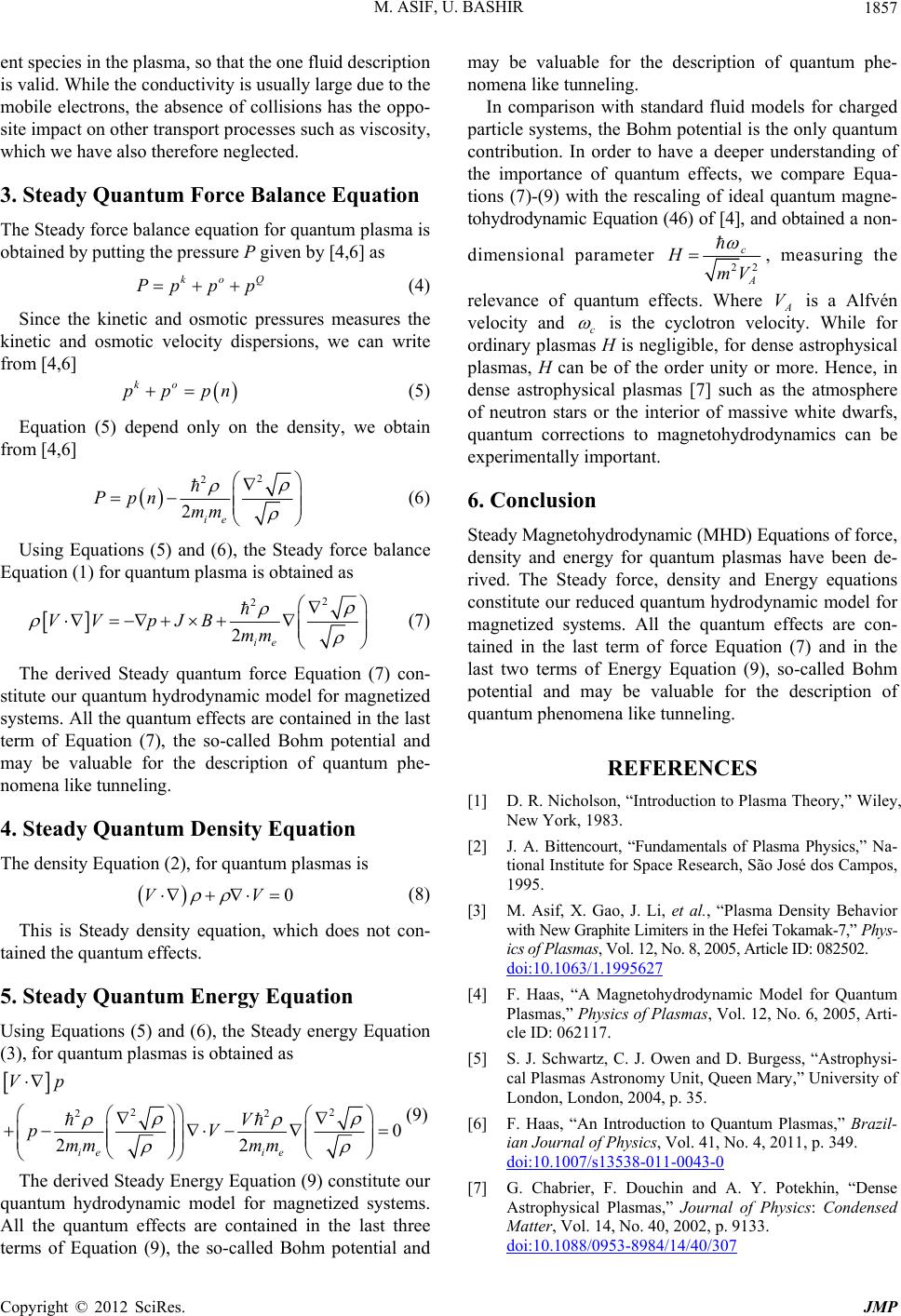
M. ASIF, U. BASHIR 1857
ent species in the plasma, so that the one fluid description
is valid. While the conductivity is usually large due to the
mobile electrons, the absence of collisions has the oppo-
site impact on other transport processes such as viscosity,
which w e h av e also therefore neglected.
3. Steady Quantum Force Balance Equation
The Steady force balance equation for quantum plasma is
obtaine d by putti ng the pressure P gi ven by [4,6] as
koQ
Pp p p
ko
pp pn
(4)
Since the kinetic and osmotic pressures measures the
kinetic and osmotic velocity dispersions, we can write
from [4,6]
(5)
Equation (5) depend only on the density, we obtain
from [4,6]
2
ie
mm
2
2
Ppn
(6)
Using Equations (5) and (6), the Steady force balance
Equation (1) for quantum plasma is obtained as
2
ie
2
2
VV pJB
mm
0VV
(7)
The derived Steady quantum force Equation (7) con-
stitute our quantu m hydrodynamic model for magnetized
systems. All the quantum effects are contained in the last
term of Equation (7), the so-called Bohm potential and
may be valuable for the description of quantum phe-
nomena like tunneling.
4. Steady Quantum Density Equation
The density Equation (2), for quantum plasmas is
(8)
This is Steady density equation, which does not con-
tained the quantum effects.
5. Steady Quantum Energy Equation
Using Equations (5) and (6), the Steady energy Equation
(3), for quantum plasmas is obtained as
2
22
22
ie ie
Vp
V
pV
mm mm
2
0
(9)
The derived Steady Energy Equation (9) constitu te our
quantum hydrodynamic model for magnetized systems.
All the quantum effects are contained in the last three
terms of Equation (9), the so-called Bohm potential and
may be valuable for the description of quantum phe-
nomena like tunneling.
In comparison with standard fluid models for charged
particle systems, the Bohm potential is th e only quantum
contribution. In order to have a deeper understanding of
the importance of quantum effects, we compare Equa-
tions (7)-(9) with the rescaling of ideal quantum magne-
tohydrodynamic Equation (46) of [4], and obtained a non-
dimensional parameter 22
c
A
H
mV
, measuring the
relevance of quantum effects. Where A
V is a Alfvén
velocity and c
is the cyclotron velocity. While for
ordinary plasmas H is n egligible, for dense astrophysical
plasmas, H can be of the order unity or more. Hence, in
dense astrophysical plasmas [7] such as the atmosphere
of neutron stars or the interior of massive white dwarfs,
quantum corrections to magnetohydrodynamics can be
experimentally important.
6. Conclusion
Steady Magnetohydrodynamic (MHD) Equations of force ,
density and energy for quantum plasmas have been de-
rived. The Steady force, density and Energy equations
constitute our reduced quan tum hydrodynamic model for
magnetized systems. All the quantum effects are con-
tained in the last term of force Equation (7) and in the
last two terms of Energy Equation (9), so-called Bohm
potential and may be valuable for the description of
quantum phenomena like tunneling.
REFERENCES
[1] D. R. Nicholson, “Introduction to Plasma Theory,” Wiley,
New York, 1983.
[2] J. A. Bittencourt, “Fundamentals of Plasma Physics,” Na-
tional Institute for Space Research, São José dos Campos,
1995.
[3] M. Asif, X. Gao, J. Li, et al., “Plasma Density Behavior
with New Graphite Li mite rs in the He fei T oka mak-7,” Phys-
ics of Plasmas, Vol. 12, No. 8, 2005, Article ID: 082502.
doi:10.1063/1.1995627
[4] F. Haas, “A Magnetohydrodynamic Model for Quantum
Plasmas,” Physics of Plasmas, Vol. 12, No. 6, 2005, Arti-
cle ID: 062117.
[5] S. J. Schwartz, C. J. Owen and D. Burgess, “Astrophysi-
cal Plasmas Astronomy Unit, Queen Mary,” University of
London, London, 2004, p. 35.
[6] F. Haas, “An Introduction to Quantum Plasmas,” Brazil-
ian Journal of Physics, Vol. 41, No. 4, 2011, p. 349.
doi:10.1007/s13538-011-0043-0
[7] G. Chabrier, F. Douchin and A. Y. Potekhin, “Dense
Astrophysical Plasmas,” Journal of Physics: Condensed
Matter, Vol. 14, No. 40, 2002, p. 9133.
doi:10.1088/0953-8984/14/40/307
Copyright © 2012 SciRes. JMP